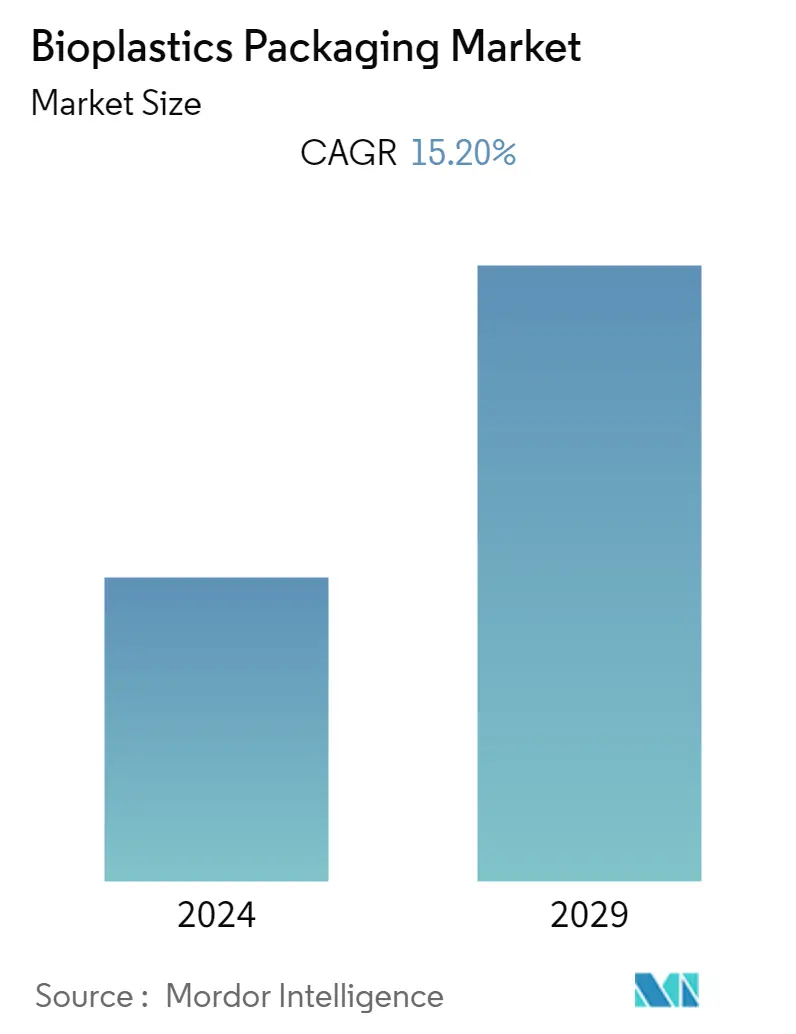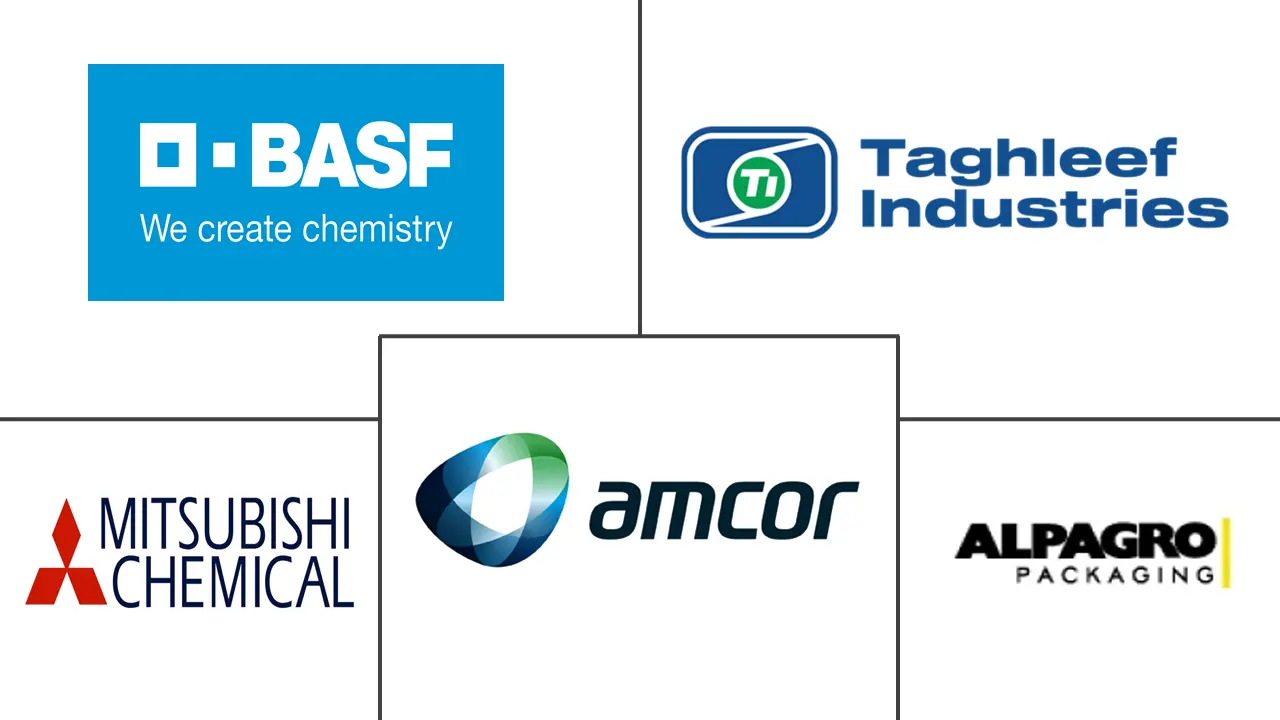Market Size of Bioplastics Packaging Industry

| Study Period | 2019 - 2029 |
| Base Year For Estimation | 2023 |
| CAGR | 15.20 % |
| Fastest Growing Market | Asia Pacific |
| Largest Market | Europe |
| Market Concentration | Low |
Major Players
*Disclaimer: Major Players sorted in no particular order |
Bioplastic Packaging Market Analysis
Bioplastics Packaging Market is expected to register a CAGR of 15.2% over the forecast period. Bioplastics packaging solutions are finding increasing applications in packaging owing to their low environmental impact, growing focus on recyclability and sustainability, government emphasis on efficient packaging management, and rising consumer awareness, coupled with increasing bans on single-use plastic.
- The overarching issue of climate change and the future scarcity of fossil resources accelerated the search for better plastic packaging concepts. Stringent government regulations against the use of conventional plastics have propelled the demand for bioplastics. Bioplastics have the potential to bypass the environmental impacts of petroleum-based plastic packaging.
- Bioplastics are plastic materials created by combining various biodegradable materials, such as biomass (plants, trees, and waste).Such materials can be utilized to reduce the dependence on fossil fuel-based plastic packaging, eventually increasing the use of green products and boosting sustainability and an inclination toward environmental protection.
- Also, governments worldwide are responding to concerns regarding packaging waste, especially plastic packaging waste, and are implementing regulations to minimize environmental waste and improve waste management processes. In all parts of the world, governments are putting more pressure on people to use traditional plastics, which is helping bioplastic grow as a stable alternative in the packaging industry.
- Emerging economies, like India, which are heavily dependent on single-use plastics, are witnessing the rigorous roll-out of legislation that bans the use of single-use plastics. For example, the environment ministry announced in August 2021 that single-use plastic items would be banned beginning July 1, 2022.The country is anticipated to witness heavy developments in the market studied to align the country's goals laid out in the Plastic Waste Management Amendment Rules, 2021.
- According to European Bioplastics (Association of Bioplastics), global bioplastics production capacity is set to increase from 2.11 million metric tons in 2020 to approximately 2.7 million metric tons in 2025. In 2020, the organization said, 1,227 metric tons of biodegradable bioplastics and 884 metric tons of bio-based non-biodegradable bioplastics were made.
- Furthermore, rising government and regulatory initiatives to promote bioplastics usage are expected to drive market growth over the forecast period.For instance, Japan unveiled a new policy to increase plant-based bioplastics to tackle marine plastic waste. in a move that would see the country recycle 100% of newly produced plastics by 2035 and promote bioplastics from plant-based sources.
- Amid the COVID-19 pandemic, the growth of the bioplastics packaging market has been severely stunted. The supply chain disruption, price hike of the raw material, and lockdowns had heavily impacted the growing market before the pandemic hit.
Moreover, changes in consumer behavior during the COVID-19 pandemic required actions concerning the adoption of bioplastics for single-use food packaging. Polylactide (PLA) was anticipated to witness significant growth due to its high production viability, performance comparable to petroleum-based thermoplastics, and carbon-neutral life cycle in the market studied over the forecast period. Further, the Russia-Ukraine war had an impact on the overall packaging ecosystem.
Bioplastic Packaging Industry Segmentation
Bioplastics are plastics derived from organic sources such as corn starch and are often polylactic acid (PLA). These plastics are increasingly being adopted in the packaging industry due to their ability to break down easily and quickly compared to standard plastics. Bioplastics Packaging Market is segmented by Material Type (BIO - PET, BIO - PE, BIO - PA, Starch Blends, PLA, PBAT, PHA), Product Type (Rigid Plastic Packaging, Flexible Packaging), End-user Industries (Food, Beverage, Pharmaceuticals, Personal Care & Household Care), and Geography (North America, Europe, Asia Pacific, Latin America, Middle East and Africa).
The market sizes and forecasts are provided in terms of value (USD million) for all the above segments.
| By Material Type | |
| BIO - PET | |
| BIO - PE | |
| BIO - PA | |
| Other Bio-Based/Non-Biodegradable Materials | |
| Starch Blends | |
| PLA | |
| PBAT | |
| PHA | |
| Other Biodegradable Materials |
| By Product Type | |
| Rigid Plastic Packaging (Bottle, Tray, Tubes, Caps, Cups, Cutlery, Blister Packaging) Non-biodegradable Biopolymers | |
| Flexible Packaging (Pouch, Film, Labels, and Others) |
| By End-user Industries | |
| Food | |
| Beverage | |
| Pharmaceuticals | |
| Personal Care & Household Care | |
| Other End-user Applications |
| By Geography | |
| North America | |
| Europe | |
| Asia Pacific | |
| Latin America | |
| Middle East and Africa |
Bioplastics Packaging Market Size Summary
The bioplastic packaging market is experiencing significant growth, driven by increasing environmental concerns and regulatory pressures against traditional plastic use. Bioplastics, made from biodegradable materials like biomass, offer a sustainable alternative to petroleum-based plastics, aligning with global efforts to reduce carbon footprints and enhance recyclability. The market is bolstered by government initiatives worldwide, aiming to curb plastic waste and promote green packaging solutions. Emerging economies are also adopting stringent regulations to phase out single-use plastics, further propelling the demand for bioplastics. The COVID-19 pandemic initially hindered market growth due to supply chain disruptions, but the shift in consumer behavior towards sustainable packaging solutions has reignited interest in bioplastics, particularly in single-use applications.
Europe stands out as a leader in the bioplastics industry, with substantial production capacity and a strong focus on research and development. The region's commitment to sustainability, exemplified by the European Green Deal, has fostered a robust market for bioplastics, supported by increasing consumer awareness and demand for eco-friendly packaging. Major companies in the bioplastics sector are expanding their market presence through strategic collaborations and innovations, aiming to meet the rising demand for sustainable packaging solutions. The industry's growth is expected to have significant economic implications, particularly in Europe, where it could drive employment and rural development. Key players in the market are actively investing in new technologies and partnerships to enhance bioplastic production and application, ensuring a competitive edge in the evolving packaging landscape.
Bioplastics Packaging Market Size - Table of Contents
-
1. MARKET INSIGHTS
-
1.1 Market Overview
-
1.2 Industry Value Chain Analysis
-
1.3 Industry Attractiveness - Porter's Five Forces Analysis
-
1.3.1 Bargaining Power of Suppliers
-
1.3.2 Bargaining Power of Buyers
-
1.3.3 Threat of New Entrants
-
1.3.4 Threat of Substitute Products
-
1.3.5 Intensity of Competitive Rivalry
-
-
1.4 Assessment of COVID-19 Impact on the Market
-
-
2. MARKET SEGMENTATION
-
2.1 By Material Type
-
2.1.1 BIO - PET
-
2.1.2 BIO - PE
-
2.1.3 BIO - PA
-
2.1.4 Other Bio-Based/Non-Biodegradable Materials
-
2.1.5 Starch Blends
-
2.1.6 PLA
-
2.1.7 PBAT
-
2.1.8 PHA
-
2.1.9 Other Biodegradable Materials
-
-
2.2 By Product Type
-
2.2.1 Rigid Plastic Packaging (Bottle, Tray, Tubes, Caps, Cups, Cutlery, Blister Packaging) Non-biodegradable Biopolymers
-
2.2.2 Flexible Packaging (Pouch, Film, Labels, and Others)
-
-
2.3 By End-user Industries
-
2.3.1 Food
-
2.3.2 Beverage
-
2.3.3 Pharmaceuticals
-
2.3.4 Personal Care & Household Care
-
2.3.5 Other End-user Applications
-
-
2.4 By Geography
-
2.4.1 North America
-
2.4.2 Europe
-
2.4.3 Asia Pacific
-
2.4.4 Latin America
-
2.4.5 Middle East and Africa
-
-
Bioplastics Packaging Market Size FAQs
What is the current Bioplastics Packaging Market size?
The Bioplastics Packaging Market is projected to register a CAGR of 15.20% during the forecast period (2024-2029)
Who are the key players in Bioplastics Packaging Market?
BASF SE (Badische Anilin- und Soda-Fabrik), TAGHLEEF INDUSTRIES GROUP, Mitsubishi Chemical Corporation, Alpagro Packaging and Amcor Limited are the major companies operating in the Bioplastics Packaging Market.

